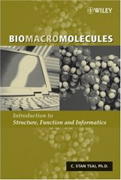This book provides an integrated treatment of the structure and
function of nucleic acids, proteins, and glycans, including thorough
coverage of relevant computational biochemistry.
The text begins with an introduction to the biomacromolecules,
followed by discussion of methods of isolation and purification,
physiochemical and biochemical properties, and structural
characteristics. The next section of the book deals with sequence
analysis, analysis of conformation using spectroscopy, chemical
synthesis, and computational approaches. The following chapters
discuss biomolecular interactions, enzyme action, gene transmission,
signal transduction, and biomacromolecular informatics. The author
concludes with presenting the latest findings in genomics,
proteomics, glycomics, and biomacromolecular evolution.
This text is an invaluable resource for research professionals
wishing to move into genomics, proteomics, and glycomics research. It
is also useful for students in biochemistry, molecular biology,
bioengineering, biotechnology, and bioinformatics.
Preface.
Abbreviations in Repetitive Use.
CHAPTER 1. INTRODUCTION.
1.1 Prelude.
1.2 Covalent Bonds.
1.3 Noncovalent Interactions.
1.4 Isomerism: Configuration versus Conformation.
1.5 Trilogy.
1.6 References.
CHAPTER 2. MONOMER CONSTITUENTS OF BIOMACROMOLECULES.
2.1 Nucleotides: Constituents of Nucleic Acids.
2.2 a-Amino Acids: Constituents of Proteins.
2.3 Monosaccharides: Constituents of Glycans.
2.4 Addendum.
2.5 References.
CHAPTER 3. PURIFICATION AND CHARACTERIZATION.
3.1 Purification: Overview.
3.2 Purification: Chromatography.
3.3 Purification: Electrophoresis.
3.4 Characterization: General.
3.6 References.
CHAPTER 4. BIOMACROMOLECULAR STRUCTURE: NUCLEIC ACIDS.
4.1 Structural Organization.
4.2 Sequence Analysis of Nucleic Acids.
4.3 Secondary Structure and Structure Polymorphism of DNA.
4.4 Supercoiling and Tertiary Structure of DNA.
4.5 Classification and Structures of RNA.
4.6 RNA Folds and Structure Motifs.
4.7 Energetics of Nucleic Acid Structure.
4.8 Nucleic Acid Application.
4.9 References.
CHAPTER 5. BIOMACROMOLECULAR STRUCTURE: PROTEINS.
5.1 Architecture of Protein Molecules.
5.2 Primary Structure of Proteins: Chemical and Enzymatic Sequence
Analysis.
5.3 Primary Structure of Proteins: Sequence Analysis by Tandem Mass
Spectrometry.
5.4 Conformational Map.
5.5 Secondary Structures and Motifs of Proteins.
5.6 Domains and Tertiary Structures of Proteins.
5.7 Classification of Protein Structures.
5.8 Quaternary (Subunit) Structures of Proteins.
5.9 Quinternary Structure Exemplified: Nucleoproteins.
5.10 Conformational Energetics.
5.11 References.
CHAPTER 6. BIOMACROMOLECULAR STRUCTURE: POLYSACCHARIDES.
6.1 Propagation of Polysaccharide Chains.
6.2 Sequence Analysis of Polysaccharides: Primary Structure.
6.3 Conformation: Secondary and Tertiary Structures of Polysaccharide
Chains.
6.4 Conformation: Description of Some Polysaccharide Structures.
6.5 Glycobiology: Study of Glycoprotein- Associated Glycans.
6.6 Neoglycoproteins.
6.7 Organizational Levels of Biomacromolecular Structures.
6.8 References.
CHAPTER 7. STUDIES OF BIOMACROMOLECULAR STRUCTURES: SPECTROSCOPIC
ANALYSIS OF CONFORMATION.
7.1 Biochemical Spectroscopy: Overview.
7.2 Ultraviolet and Visible Absorption Spectroscopy.
7.3 Fluorescence Spectroscopy.
7.4 Infrared Spectroscopy.
7.5 Nuclear Magnetic Resonance Spectroscopy.
7.6 Optical Rotatory Dispersion and Circular Dichroism Spectroscopy.
7.7 X-ray Diffraction Spectroscopy.
7.8 References.
CHAPTER 8. STUDIES OF BIOMACROMOLECULAR STRUCTURES: CHEMICAL
SYNTHESIS.
8.1 Rationale.
8.2 Synthetic Strategy: Conventional Approach.
8.3 Synthetic Strategy: Solid Phase Approach.


